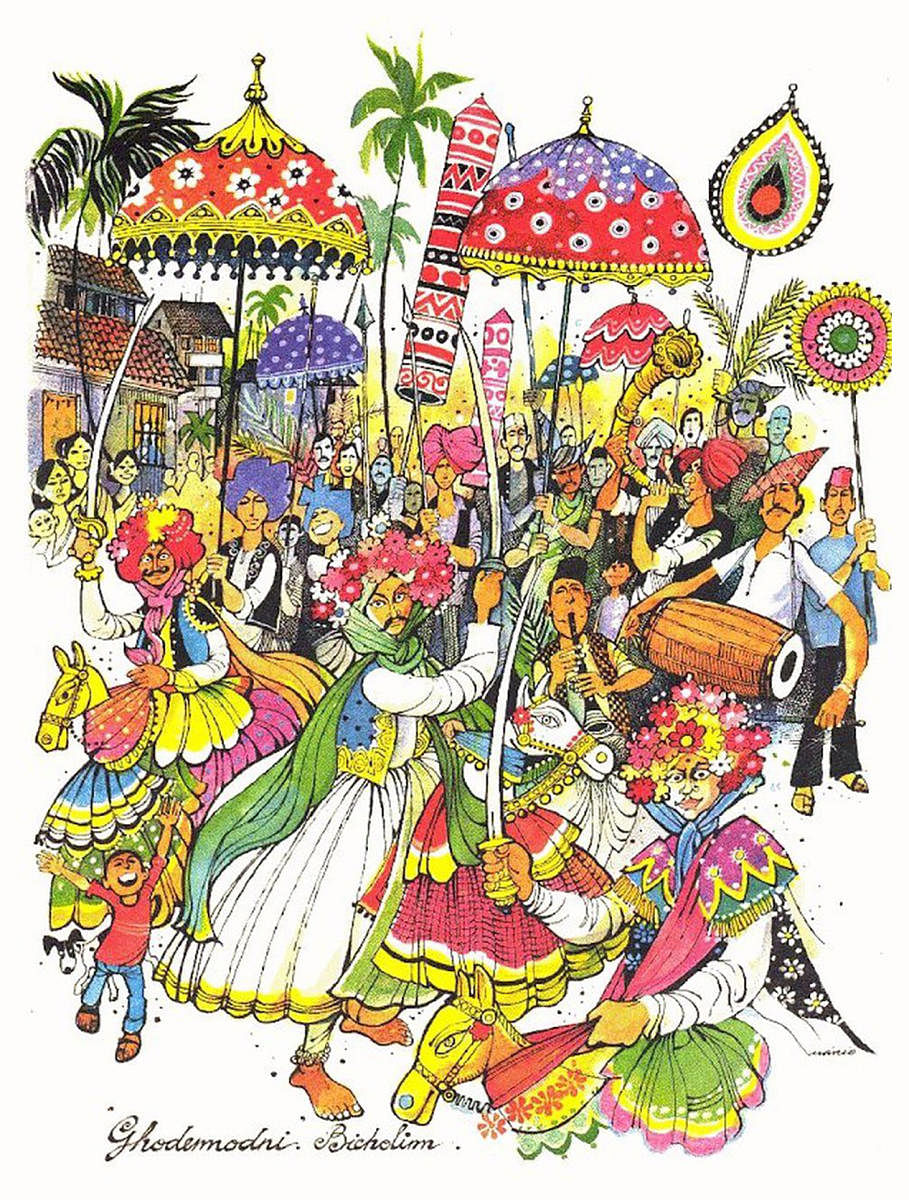
“Hearing the news of the death of cartoonist Mario Miranda was like someone slinging a dagger in my heart,” wrote Khushwant Singh (‘Last Salute to a Dear Friend’/ 24 Dec 2011). Singh was the editor of the Illustrated Weekly of India during 1969-1978, and Mario’s cartoons were integral to the highly circulated magazine. The Weekly’s popular ‘Editor's Page’ had Mario’s iconic ‘man-in-the-bulb logo’ cartoon showing the Sardarji with pen in hand; strewn around were a pile of books, a bottle of scotch, and adult magazines. The bulb logo continued to accompany Singh’s articles for decades. “Believe it or not,” wrote Singh, “on many occasions, I have received letters simply addressed to: "Man-in-the-bulb, New Delhi!”
Mario was 85 when he died in his sleep in Loutolim village in South Goa on 11 December 2011. After a funeral mass at the Saviour of the World Church, his last rites were performed, as per his wishes, at the Hindu crematorium in Margao. The much-loved and soft-spoken artist, who remained wedded to his art all his life, was stricken by Parkinson's in his final years. The condition made it difficult for him to hold the pen and control the lines of his drawings. But nothing could prevent him from remaining active till the last. “Two days before his death, I met Mario at Nostalgia, a gourmet Goan restaurant, where he shared a hearty meal with wife Habiba, a glass of red wine in his hand,” recalled popular musician Remo Fernandes.
In a long and illustrious career, Mario worked with several editors and writers. Thousands of his delightful cartoons adorned the pages of leading newspapers, magazines and books. He created colourful characters like the bosomy filmstar Miss Rajani Nimbupani, wide-eyed Anglo-Indian secretary Miss Fonseca, office clerk Godbole, and the uncouth politician Bundaldass. He captured the essence of wayside bazaars, hotels, bars, restaurants, and other public/private spaces teeming with people in incredible poses and expressions. He illustrated several books of eminent authors, including Dom Moraes (A Journey to Goa / The Open Eyes: A Journey through Karnataka), Manohar Malgaonkar (Inside Goa), and Adam Clapham (Beware Falling Coconuts: Perspectives of India by a BBC Producer).
A detached observer
Born in Daman, raised in Goa, educated in Bengaluru (St Joseph’s High School) and Mumbai (St Xavier’s College /BA with Honours in English), Mario was never trained in art. “I went to an art school for only one day; I didn’t like it, and left immediately.” His art was inspired by people, places, and buildings — both ordinary and exotic. “I don’t like to be in a crowd. But I love to observe people, and watch crowds. There are people everywhere in India; in different sizes, shapes and colours. Nowhere in the world do we find such diversity. They are all doing something or the other. I love to make sketches and drawings of them and their activities.”
Mario was an inveterate traveller. As his popularity soared, he was invited by several countries to visit and sketch. While on travels within the country or outside, his sketchbooks never rested. He filled pages and pages with drawings and cartoons in his signature style of sturdy lines and lilting humour.
Writer and editor Vinod Mehta, who was his co-traveller to Germany in 1977, observed that Mario possessed the attitude of a ‘detached observer, the outsider looking in, the artist passing by’. This attitude lent his drawings a clarity, sharpness, and integrity unsullied by ill-digested ideology or spurious subjectivity. “Mario takes no sides, has no axe to grind; he records with sympathy and accuracy the scene as he sees it.” According to Mehta, Mario’s work showed a command over the grammar of drawing, which none of his contemporaries possessed. “I believe that in his quiet, wry, ironic, detached way, Mario gets his message across.”
A pure humourist
Mario was known to be a simple, fun-loving, and easy-going person. He had a large posse of friends and admirers. Despite his immense popularity, he remained modest and ever supportive of young and upcoming artists. “Mario is essentially a simple, integrated person, with the extraordinary strength that comes from simplicity and integration,” observed noted poet Nissim Ezekiel. “He has no pretensions to ideology or intellectual attitudes… There is no rage or revulsion … He makes fun of reality for being what it is, not because he wants it different. He is no idealist or dreamer. He is a pure humourist.”
Mario’s art was well recognised during his lifetime. Among others, he was decorated with the Padma Shri (1988), and the Padma Bhushan (2002). A staunch advocate for conserving Goa’s heritage, monuments, and environment, he initiated the Christian Art Museum, and helped in the restoration of Reis Magos fort and St Anne's Church.
As a cartoonist, Mario did face criticism from some quarters. His work was seen to be too gentle and good-natured, lacking in bite or punch. He was also inevitably compared with R K Laxman, the pre-eminent cartoonist of the day.
Writer-journalist Rahul Singh, who was well acquainted with both, wrote: “India's best-known cartoonist is R K Laxman. There can be little doubt about that. However, Laxman has few pretensions of being an artist. He is essentially a political cartoonist and social satirist… As an illustrator, however — and a very versatile one at that — Mario was far superior to Laxman.”
In a later column, Singh was even more forthcoming. “Laxman may have been more famous, but Mario was by far the more popular man, easily socialising and constantly having people at home…Laxman was a bit of a snob and a dandy; Mario, a fun-loving extrovert Goan.” On his part, Mario did not seem to be affected by comparisons. “I don’t like to make a big noise about myself,” he once told an interviewer. “I don’t deserve so much. There are better cartoonists than me.”